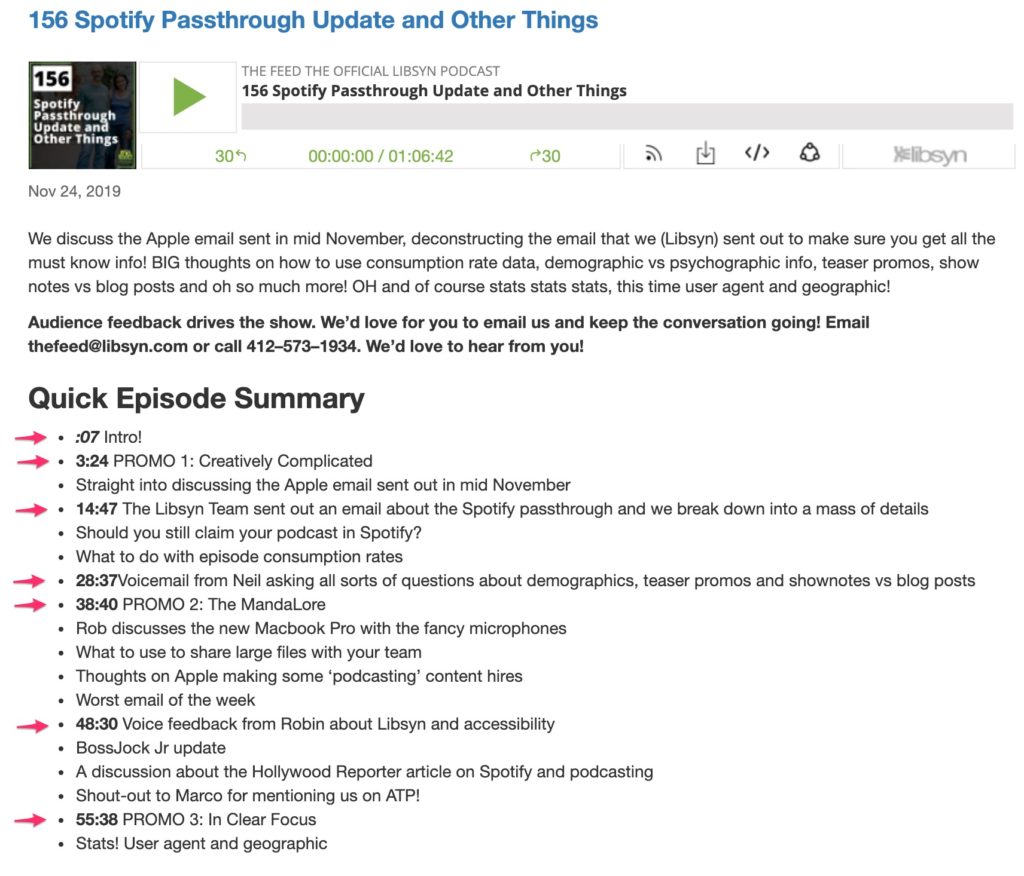
Last week, I wrote about how radio shows — especially morning shows — can borrow the practice of creating “shownotes” pages from podcasters and use them as part of a broader digital strategy to grow their audience through email, social media, and search engines. In that post, I outlined the broad strategy. In this post, I’ll take a closer look at some of the elements that radio DJs might want to include on their shownotes pages.
At its core, a “shownotes” page is simply a webpage that contains a recording of the show and supplemental material. A radio show will produce one page for each show, just as a podcaster produces one for each episode. So a daily morning show will produce five shownotes pages per week, while a Saturday morning show would only produce one per week. The benefit of a shownotes page is that it provides you with a link to a page on your website, which you can share on social media, you can email to subscribers, and can be discovered through search engines like Google. This drives traffic back to your radio station’s website. Moreover, it gives people an incentive to sign up for your station’s email list.
To do all that, however, the shownotes pages will need to be compelling content, not just an afterthought. If your shownotes pages aren’t worthy of a click, they won’t move the needle. With that in mind, here are elements to consider including in your shownotes pages to ensure their quality:
1. A Recording of the Show
The most important element of a shownotes page is an embedded recording of the show. There are a number of different ways to include this. If the radio show is regularly repackaged as a podcast, you can embed an audio player with the entire show. If your radio show is livestreamed as video on social media, you can embed the video recording.
You can also break up the recordings of the show into multiple embedded players. For example, if you have a popular signature feature or celebrity interviews, you may want to separate them out in addition to the recording of the whole show so fans can easily listen to the thing that interests them most.
2. The Air Date
At the risk of stating the obvious, don’t forget to include the date that the show aired, which should be the same as the date that the shownotes page is published.
3. A Summary of the Show
Include a short summary of the day’s show. Visitors will read this text when deciding if they want to press play on your embedded player. This text can also be used on social media, in email campaigns, in search engine results, and on your website’s archive page that displays links to all of your shownotes page.
4. A Timeline
Some podcasts, especially those that cover multiple topics in each episode, include a timeline to accompany their recordings. For example, Libsyn does this with The Feed podcast. Life coach Tony Robbins also does it with his podcast. This allows people to easily skip to the part of the episode that they’re most interested in. For radio shows, which also cover a wide range of topics, a timeline is probably a wise thing to include.

5. An Image
Always include at least one image on your shownotes page. Not only does this make the page visually more interesting, but the image can be used on social media, included in the email blast, used on your website’s archive page, and may help with search engine rankings. Ideally, you’ll be able to get an image that is unique to that show, such as a headshot of a guest that you interview. If not, capture a variety of shots of the show hosts that you can rotate through to minimize repetition.
6. Links to Things Discussed on the Show
If you discuss things on the show — for example, a new story about a Florida man doing something stupid — provide a link to it on your shownotes pages. This allows your listeners to get more information and can also help with your search engine rankings.
Be especially vigilant about links to local people or organizations that you discuss on your show. You can use these links to proactively share your shownotes pages on social media and tag them. This increases the chances that they will then share the link with their followers and make it go viral. This video shows the process:
7. Embedded Videos of Things Discussed on the Show
If you discuss a video on the air during your show, embed it on the shownotes page for people to see. For example, movie trailers and music videos are great additions to a shownotes page. Grab the video link or embed code from YouTube and add it to your shownotes page. This also gives you an opportunity to plug your station’s website on the air: “If you want to see the video, go to our website.”
8. Calls to Action
What do you want people to do when they visit your shownotes page? Listen to the show? Yes. Sign up for the email list? Yes. Subscribe to the podcast? Yes. Your shownotes pages should emphasize these calls to action through color, space, and on-screen location. Here are some tips on strengthening your calls to action.
As you incorporate these elements into your shownotes pages, remember to keep your writing in the same voice as your radio show. If the show is fun and casual, don’t make the shownotes sterile or clinical. These pages should embody the spirit of your show because they will represent it online and strengthen your bonds with listeners.
- A Simple Digital Treat to Thank Your Radio Listeners This Thanksgiving - November 13, 2023
- Interview Questions When Hiring Your Radio Station’s Next Digital Marketing Manager - November 6, 2023
- A Radio Conversation with ChatGPT: Part 2 – Promotions - October 30, 2023





Leave a Reply